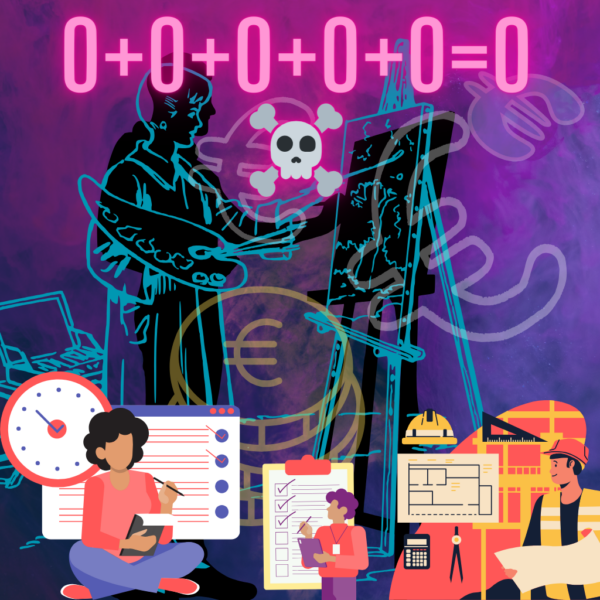Frédéric Naud
French Contemporary Sculptor
Human engineering is just a natural organic process.
Surviving as an artist!

In Praise of the Artistic Misery in which our society is immersed.
Let’s start with the facts. An animated work, created in collaboration with 3 other artists and requiring 1 year’s work, is used with 300 other works by other artists to decorate a building entrance hall for 3 years.
The artists’ remuneration level for this is €0…
The genesis of the project is a building obviously created by an architect’s inflated ego. Overwhelming, sterile, with no room for human beings, but for which the author has been paid.
I invite you to visit this place (3 mail du front populaire, 44000 Nantes) and see for yourself. The managers of this coworking space feel it and live it: something has to be done, but what?
But the first reflex is the right one: only art can work to bring back the living and the humanity that have been forgotten and abused in the very conception of this building.
And I mean art, not decoration.
But how is it that, despite the obvious fact that art can provide something so essential to life in a place, no budget has been set aside to feed the artists who work to produce this indispensable material?
There’s a budget for the building, a budget for its upkeep, a budget for those who take care of the upkeep, there’s a budget for everything, even toilet paper, but not for what everyone finds lacking! Make people want to live in this building.
Is it just me?
So far, nothing from the sponsors, nothing from the organizers, nothing from the users, who don’t even ask the question, and nothing even from the artists…
How did we get here?
This raises the question of the real place of art and artists in the value scale of our contemporary, capitalist societies.
Despite the prestigious exhibitions of some of the world’s best-known artists, mainly to promote private collections. The acclaimed art of tomorrow, produced today by artists who are sometimes completely unknown, remains poor and devalued.
Let’s take a look at how, in such a rich and so-called modern society, the producers of culture, the cement that holds a society together, are unable to make a living from their work.
Like all professions that produce goods and services, the true creators of value are inexorably plunging into financial and existential insecurity.
The first question is: Is being an artist a profession?
It’s important to ask yourself this question, because if art is a hobby or a passion, then it’s quite conceivable that you won’t be able to make a living from it.
But if art heals, if art educates, if art nourishes, if art produces a market, then just like agriculture, banking or education, art is a professional activity, which demands remuneration and rights in return for the work it provides.
To delve deeper, being an artist requires much more than passing a diploma. It doesn’t result from the simple application of all-powerful methods.
It’s one of those rare professions where, to produce true art, you have to start by plunging into the heart of your individuality. Discovering who you are and what’s different about you, in order to express it through a singular rendering, mastering different techniques to give life to a work of art…
This job requires personal exploration, taking the time we have less and less, to let ourselves become what we really are.
Once that’s said, it’s clear that what is produced by artists who have taken this path is rare and precious. Individuals who decide to embark on this path must be determined and convinced, but above all, they have no choice – it’s who they are.
This path, like many others, is most often one of precariousness, distress, doubt and suffering, with the unique and frequent feature of leading to recognition after the author’s death.
Self-destructive French myth of the artist, including total sacrifice during life for postmortem glory.
Oh oh, perhaps this is the emerging key to understanding this situation.
- Standardization, which smoothes out individuality and makes it harder to access and recognize the value of individual artistic expression.
- A general devaluation of those who produce value, to the benefit of intermediate professions, which become more legitimate in accumulating wealth.
- The precariousness resulting from the first, which implies a double phenomenon.
- We’re satisfied with very little, but to be presented is already something, so let’s not offend anyone by asking for payment. I could almost have paid to be seen.
- And a predominant individualism with a total absence of solidarity, which would otherwise result in a non-remunerative project that would find no participants and be denounced by a strong, close-knit community. Just like the NFT community.
- And finally, an indirect social pressure, reminiscent of a collective fantasy, which dictates that true art, created by an artist who was a genius in his time, must be accompanied by a total and devoted sacrifice to his art from birth to death.
You might ask, what about me?
Cowardly and miserable like the others, I accept to be used for 3 years without getting any money, because I tell myself that maybe this is what will get something started. Being seen is better than being invisible.
I accept this sacrifice and this social uselessness in the hope of leaving something greater after me. A small pawn in the myth of the misunderstood artist of his time.
Resigned, how can I change the image that society has of my artistic work and my place within it ?

